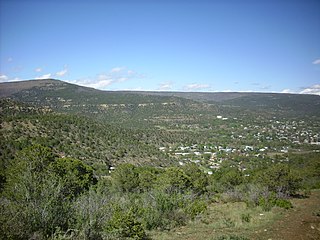
The Moenkopi Formation is a geological formation that is spread across the U.S. states of New Mexico, northern Arizona, Nevada, southeastern California, eastern Utah and western Colorado. This unit is considered to be a group in Arizona. Part of the Colorado Plateau and Basin and Range, this red sandstone was laid down in the Lower Triassic and possibly part of the Middle Triassic, around 240 million years ago.

The Chinle Formation is an Upper Triassic continental geological formation of fluvial, lacustrine, and palustrine to eolian deposits spread across the U.S. states of Nevada, Utah, northern Arizona, western New Mexico, and western Colorado. The Chinle is controversially considered to be synonymous to the Dockum Group of eastern Colorado and New Mexico, western Texas, the Oklahoma panhandle, and southwestern Kansas. The Chinle is sometimes colloquially named as a formation within the Dockum Group in New Mexico and in Texas. The Chinle Formation is part of the Colorado Plateau, Basin and Range, and the southern section of the Interior Plains.

The San Juan Basin is a geologic structural basin located near the Four Corners region of the Southwestern United States. The basin covers 7,500 square miles and resides in northwestern New Mexico, southwestern Colorado, and parts of Utah and Arizona. Specifically, the basin occupies space in the San Juan, Rio Arriba, Sandoval, and McKinley counties in New Mexico, and La Plata and Archuleta counties in Colorado. The basin extends roughly 100 miles (160 km) N-S and 90 miles (140 km) E-W.

The Laramie Formation is a geologic formation of Late Cretaceous (Maastrichtian) age, named by Clarence King in 1876 for exposures in northeastern Colorado, in the United States. It was deposited on a coastal plain and in coastal swamps that flanked the Western Interior Seaway. It contains coal, clay and uranium deposits, as well as plant and animal fossils, including dinosaur remains.

The Raton Basin is a geologic structural basin in southern Colorado and northern New Mexico. It takes its name from Raton Pass and the town of Raton, New Mexico. In extent, the basin is approximately 50 miles (80 km) east-west, and 90 miles (140 km) north-south, in Huerfano and Las Animas Counties, Colorado, and Colfax County, New Mexico.

The Williston Basin is a large intracratonic sedimentary basin in eastern Montana, western North Dakota, South Dakota, and southern Saskatchewan, that is known for its rich deposits of petroleum and potash. The basin is a geologic structural basin but not a topographic depression; it is transected by the Missouri River. The oval-shaped depression extends approximately 475 miles (764 km) north-south and 300 miles (480 km) east-west.

Vermejo Park Ranch, Vermejo Ranch, or Vermejo, is a 550,000-acre (220,000 ha) nature reserve and guest ranch in northeastern New Mexico and southern Colorado. Ted Turner Reserves, the luxury hospitality company founded by Ted Turner includes conservation research and ecosystem restoration along with guest operations. The reserve, which stretches from the Great Plains to the summit of the Sangre de Cristo Mountains produces significant quantities of coalbed methane, a type of natural gas.

The Pierre Shale is a geologic formation or series in the Upper Cretaceous which occurs east of the Rocky Mountains in the Great Plains, from Pembina Valley in Canada to New Mexico.

The Raton Formation is a geological formation of Upper Cretaceous and Paleocene age which outcrops in the Raton Basin of northeast New Mexico and southeast Colorado.

The Pictured Cliffs Formation is a Campanian geologic formation in the San Juan Basin of New Mexico. Dinosaur remains are among the fossils that have been recovered from the formation, although none have yet been referred to a specific genus.

The Point Lookout Sandstone is a Cretaceous bedrock formation occurring in New Mexico and Colorado.

The Mancos Shale or Mancos Group is a Late Cretaceous geologic formation of the Western United States.

The Poison Canyon Formation is a geologic formation in the Raton Basin of Colorado and New Mexico. The formation was deposited from the late Cretaceous through the Paleocene.

The Yeso Group is a group of geologic formations in New Mexico. It contains fossils characteristic of the Kungurian Age of the early Permian Period.

The Travesser Formation is a geologic formation in northeastern New Mexico, southeastern Colorado, westernmost Oklahoma, and northwestern Texas, particularly in the Dry Cimarron valley. It preserves fossils dating back to the late Triassic period.

The Mesaverde Group is a Late Cretaceous stratigraphic group found in areas of Colorado, New Mexico, Utah, and Wyoming, in the Western United States.

The Lytle Formation or Lytle Sandstone is a geologic formation found in Wyoming, Colorado, and New Mexico.

The Exeter Sandstone is a geologic formation exposed in northeastern New Mexico. Its age is poorly controlled, but it is thought to have been deposited during the middle Jurassic.

The Glencairn Formation is a geologic formation found in Colorado and New Mexico. It preserves fossils characteristic of the Albian Age of the Cretaceous Period.

The Trinidad Sandstone is a geologic formation in northeastern New Mexico and southeastern Colorado. It was formed during the Campanian Age of the Cretaceous Period and contains fossils.



















